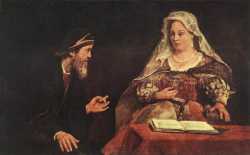Esther
The queen of Ahasuerus, and heroine of the biblical book that bears her name. She was a Jewess named Hadassah ("myrtle"), but when she entered the royal harem she received the name by which she henceforth became known.1 The name is a Syro-Arabian modification of the Persian word setareh, which means a star, and which was given to her because she was as beautiful as the morning star.2 She was the daughter of Abihail, a Benjamite. Her family did not avail themselves of the permission granted by Cyrus to the exiles to return to Jerusalem; and she resided with her cousin Mordecai, who held some office in the household of the Persian king at "Shushan in the palace."
Ahasuerus having divorced Vashti, chose Esther to be his wife. Soon after this he gave Haman the Agagite, his prime minister, power and authority to kill and extirpate all the Jews throughout the Persian empire. By the interposition of Esther this catastrophe was averted. Haman was hanged on the gallows he had intended for Mordecai;3 and the Jews established an annual feast, the feast of Purim, in memory of their deliverance. This took place about fifty-two years after the Return, the year of the great battles of Plataea and Mycale (479 BCE).
❧
References
Notes
Source
- Easton, M.G. (1897). Easton's Bible Dictionary. New York: Harper & Brothers.
This article incorporates text from Easton’s Bible Dictionary (1897) by M.G. Easton, which is in the public domain.
